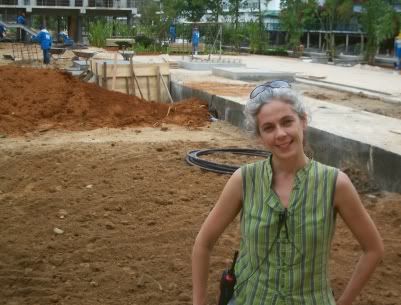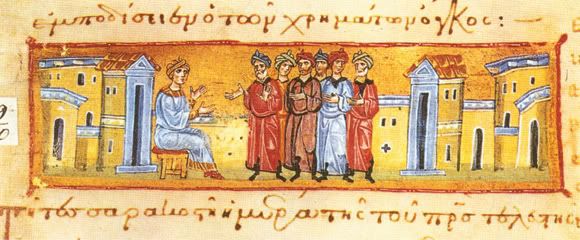Thứ Ba, ngày 19 tháng 7, 2005
 KAMALA: Chương trình TV Phổ thông Úc châu chuyên đề làm vườn có tên Hậu Viên Chớp Nhoáng đang làm một việc bất ngờ để cúng dường buổi Lễ Nhập Hạ tại tu viện Wat Kamala nơi bị sóng thần tsunami đánh vào – cảnh quang của một khu vườn mới trong chớp nhoáng .
KAMALA: Chương trình TV Phổ thông Úc châu chuyên đề làm vườn có tên Hậu Viên Chớp Nhoáng đang làm một việc bất ngờ để cúng dường buổi Lễ Nhập Hạ tại tu viện Wat Kamala nơi bị sóng thần tsunami đánh vào – cảnh quang của một khu vườn mới trong chớp nhoáng .Chương trình đặc biệt của TV Úc Châu nhằm hướng dẫn việc cải tiến những khu vườn cho khán giả là một chương trình phổ thông đêm Chủ Nhật. Đây là lần đầu tiên một tiết mục được thâu tại hải ngoại.
Bà Jacq Brophy, giám đốc sản xuất, đã nói với báo địa phương Phuket Gazette rằng ngày hôm qua Cơ quan hữu trách Du Lịch Thái Lan (TAT) tại Úc Châu đã đến thăm viếng và mời nhóm này làm một chương trình chớp nhoáng 48 giờ trên khu vườn bị tàn phá trong cơn sóng thần tsunami ở Phuket.
“Chúng tôi đến đây vào tháng Năm và ở lại sáu ngày quan sát tình hình. Cuối cùng, chúng tôi quyết định dùng ngôi tu viện này làm trung tâm cho cộng đồng.”
“Phải mất sáu tuần lễ trở về Úc Châu để phác họa sơ đồ khu vườn. Vị Trụ trì giúp đỡ rất nhiều khi Ngài giải thích ý nghĩa của nhiều biểu tượng Phật Giáo nên chúng tôi có thể kết hợp những biểu tượng này vào trong toàn bộ sơ đồ khu vườn.”
Nhóm khởi sự công việc vào ngày 18 tháng 7. Dự án được hoàn thành trong vòng 48 giờ, đúng thời hạn cho ngày Hội Lễ Nhập Hạ.
Bà Brophy tiếp tục nói: “Chúng tôi đưa một nhóm gồm 17 hội viên từ Úc châu sang và mướn khoảng 60 nhân công địa phương. Khi chương trình của chúng tôi đã chặt chẽ chúng tôi làm việc theo phiên.
Chúng tôi hơi lo lắng vì thời tiết dường như đang đe dọa và gió thổi mạnh vào sáng hôm qua, nhưng chúng tôi may mắn là không sao cả. Thật tuyệt diệu làm ngạc nhiên mọi người bởi sự hiện diện của tu viện Wat Kamala với một khu vườn mới trong ngày lễ Nhập Hạ.
Bà Brophy giải thích rằng tất cả các cây trồng dùng trong chương trình “Chớp Nhoáng ” được mua tại Phuket, với thêm một số vật liệu thu được tại Bangkok.
Bà nói: “Chúng tôi cung ứng một số ngân sách và TAT giúp đỡ, cũng như vài vị bảo trợ Úc Châu. Ngày Lễ Qantas cho chúng tôi một chương trình quảng cáo đặc biệt với một chuyến bay hợp đồng trực tiếp từ Sydney đến Phuket.”
(tinhtan luoc dich)
Wat Kamala to be ‘blitzed’
Tuesday, July 19, 2005
KAMALA: Popular Australian TV gardening program Backyard Blitz is to spring a Buddhist Lent surprise on tsunami-hit Wat Kamala – in the shape of a newly-landscaped garden.
The program specializes in renovating viewers’ gardens along themed lines and is a popular Sunday evening show. This is the first time an episode has been recorded overseas.
Jacq Brophy, Head of Production, told the Gazette yesterday that the Tourism Authority of Thailand (TAT) in Australia had approached and invited the team to do a 48-hour “blitz” on a tsunami-ravaged garden in Phuket.
“We came here in May and spent six days reconnoitering. We finally decided on the temple as it is the center of the community.
“It took about six weeks back in Australia to design the garden plans. The abbot was very helpful as he explained the meanings of a lot of Buddhist symbols so we could incorporate them into the overall garden plan.”
The team started work July 18. The project was due for completion within 48 hours, in time for the Buddhist Lent Festival.
Ms Brophy continued, “We brought a 17-member team from Australia and employed about 60 local workers. As our schedule is tight we work shifts.
“We were a bit worried as the weather seemed threatening and it was very windy yesterday morning, but we’re lucky that it hasn’t broken. It’d be great to surprise everyone by presenting the wat with a new garden on Buddhist Lent day [Asarnha Bucha].”
She said that curious locals had been along to have a peek at the proceedings, but that it was hard to explain the TV program’s concept to them because nothing like it exists in Thailand. She believed, however, that people were happy with what the team was doing.
Ms Brophy explained that the all the plants used in the “blitz” were bought in Phuket, with some extra materials obtained in Bangkok.
“We supplied some of the budget and the TAT helped out, as well as some Australian sponsors. Qantas Holidays gave us a special package with a direct charter flight from Sydney to Phuket.”
About 200 package-holiday guests will be invited to view the filming session and to attend a post-production party with the crew.
Ms Brophy said, “On Thursday morning the Australian Ambassador [to Thailand] will travel with his family to Phuket. They will visit us and have a look at what we have done, because he gave his support for a general fundraising project for the temple.”
“The program will be broadcast at 6:30 pm on September 11 on Channel 9 in Australia. Phuket is one of Australians’ top 10 travel destinations and I believe the program will help to promote tourism [in Phuket] because we will film many places around the island,” she added.
http://feeds.bignewsnetwork.com/redir.php?jid=82166f81aa875bbf&cat=f97ff7b11934dbb6
 “Truyền thuyết cổ xưa về Cồ Ðàm Sĩ Ðạt Ta, người khai sáng Phật Giáo, đã lan truyền từ quê hương Ngài sang Âu Châu, nơi mà Ngài trở thành một vị Thánh Thiên Chúa Giáo với tôn danh “Iosaphat”
“Truyền thuyết cổ xưa về Cồ Ðàm Sĩ Ðạt Ta, người khai sáng Phật Giáo, đã lan truyền từ quê hương Ngài sang Âu Châu, nơi mà Ngài trở thành một vị Thánh Thiên Chúa Giáo với tôn danh “Iosaphat”